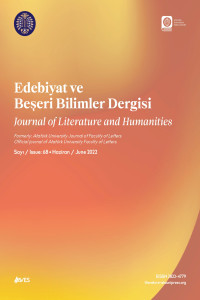A MODERN EXILE: HOME AND BELONGING IN FOR LOVE ALONE/Modern Bir Sürgün: For Love Alone Romanında Yuva ve Aidiyet İncelemesi
AbstractThis study examines the transforming notions of home, belonging and exile in For Love Alone by Christina Stead and suggests that the heroine Teresa represents a modern exile who searches for love, knowledge and freedom in the imperial context of the early twentieth century. Teresa's experiences are both shaped and constrained by her family relations, gender, colonial and imperial status, and her cultural and geographical bonds with Great Britain. Her voyage from Sydney to London, in this sense, symbolises a continuous struggle against all kinds of social, cultural and historical pressures at the intersection of modernity and imperialism in the 1920s and 1930s. Teresa, as an Australian white woman, cannot develop a sense of belonging by oscillating between exploited and colonial lands. In time, she gets rid of herties to objects, people and places, and for her the real home becomes a world of love, knowledge and independence.Keywords: For Love Alone, Home and Belonging, Modern Exile,ÖzBu çalışma, Christina Stead'in For Love Alone adlı eserinde yuva, aidiyet ve sürgün kavramlarını incelemekte ve kadın kahraman Teresa'nın yirminci yüzyılın başlarında sevgi, bilgi ve özgürlüğü arayan modern bir sürgünü temsil ettiğini öne sürmektedir. Teresa'nın deneyimleri, onun aile ilişkileri, cinsiyeti, sömürgeci ve emperyal durumu, ve Büyük Britanya ile olan kültürel ve coğrafi bağlarıyla hem şekillenir hem de kısıtlanır. Bu anlamda, Sidney'den Londra'ya yaptığı yolculuk, 1920 ve 1930'larda modernite ve emperyalizmin kesişme noktasında her türlü sosyal, kültürel ve tarihsel baskıya karşı sürekli bir mücadeleyi sembolize eder. Avusturalyalı beyaz bir kadın olan Teresa, sömürülen topraklar ile sömürgeci topraklar arasında kalarak, bir aidiyet duygusu geliştiremez. Zamanla nesnelere, insanlara ve mekanlara olan bağlarından kurtulur ve onun için asıl yuva, sevgi, bilgi ve bağımsızlık dünyası olur. Anahtar Kelimeler: For Love Alone, Yuva ve Aidiyet, Modern Sürgün, Christina Stead
Anahtar Kelimeler:
For Love Alone, Home and Belonging, Modern Exile
___
- Armstrong, T. (2005). Modernism. Cambridge: Polity Press. Birns, N. (2015). "Christina Stead: Australian in Modernity", in Contemporary Australian Literature: A World Not Yet Dead (pp. 25-44). Sydney: Sydney University Press. https://www.jstor.org/stable/j.ctt19qgddn.6 Blake, A. (1994). "An Ocean of Story: The Novels of Christina Stead". Critical Survey 6 (1), pp.118-124. https://www.jstor.org/stable/41556568 Brydon, D. (1987) Christina Stead. Totowa: Barnes & Noble Books. Davis, K. & Halleh, G. & Peer S. (2018). Contested Belonging: Spaces, Practices, Biographies. UK: Emerald Publishing. Geering, R. G. (1969). Christina Stead: Australian Writers and Their WorkMelbourne: Oxford University Press. Harris, M. (2000). The Magic Phrase: Critical Essays on Christina Stead. StLucia, Qld.: University of Queensland Press. Houston Jones, E. (2007). Spaces of Belonging: Home, Culture, and Identity in 20th Century French Autobiography. Amsterdam: Rodopi. Naficy, H. (1999). Home, Exile, Homeland: Film, Media, and the Politics of Place. New York: Routledge. Parsons, D. L. (2000). The Metropolis: Women, the City and Modernity. NewYork: Oxford University Press. Raskin, J. (1970). "Christina Stead in Washington Square". London Magazine, 9(11), pp.70-75. Said, E. W. (1994). Culture and Imperialism. New York, First Vintage Books. Sheridan, S. (1988). Christina Stead. Bloomington: Indiana University Press. Stead, C. (1978 [1945]). For Love Alone. London: Virago Press.
- Yayın Aralığı: Yılda 2 Sayı
- Başlangıç: 1970
- Yayıncı: Atatürk Üniversitesi
Sayıdaki Diğer Makaleler
Cengiz KILIC, Hande ŞAHİN, Gülay GÜNAY
EL YAZMA SEÇKİ ÖRNEĞİ OLARAK BEYAZ-I HĀZIK/ Beyaz-ı Hāzık as an Example of Manuscript Selection
EVHADÜDDÎN-İ MERÂGÎ’NİN GAZELLERİNDE TELMÎH/ Telmih in Evhaduddin-i Merâgi’s Ghazel
Asuman GÖKHAN, Esengül UZUNOĞLU SAYIN
Reva BALCI AKPINAR, Sibel KÜÇÜKOĞLU, Serap EJDER APAY, Nuray KARACA, Aslı BALCI
